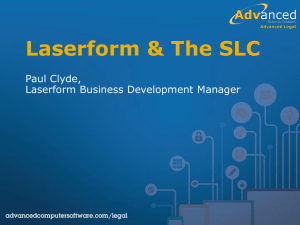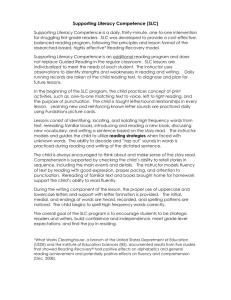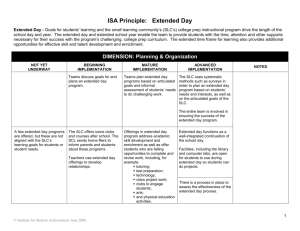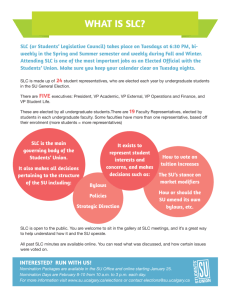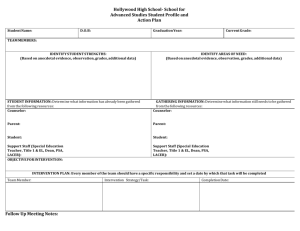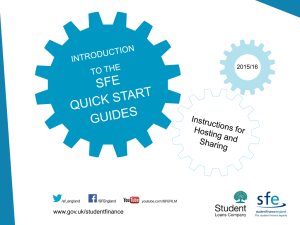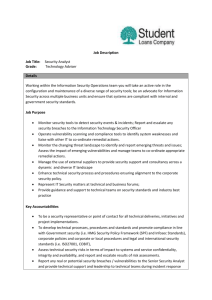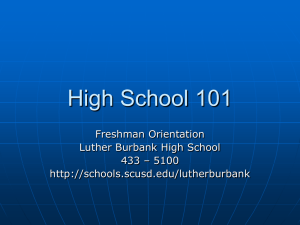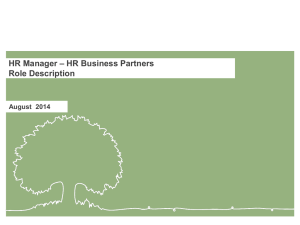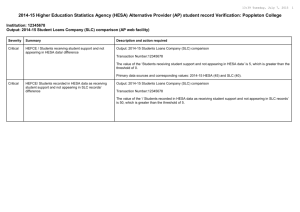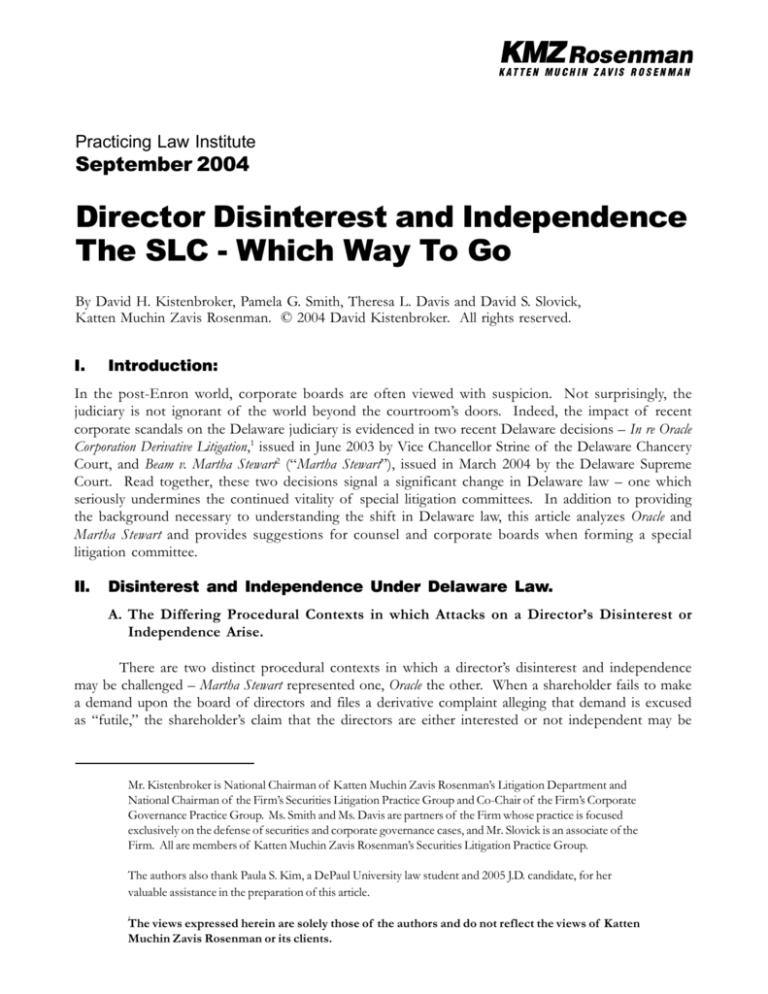
Practicing Law Institute
September 2004
Director Disinterest and Independence
The SLC - Which Way To Go
By David H. Kistenbroker, Pamela G. Smith, Theresa L. Davis and David S. Slovick,
Katten Muchin Zavis Rosenman. © 2004 David Kistenbroker. All rights reserved.
I.
Introduction:
In the post-Enron world, corporate boards are often viewed with suspicion. Not surprisingly, the
judiciary is not ignorant of the world beyond the courtroom’s doors. Indeed, the impact of recent
corporate scandals on the Delaware judiciary is evidenced in two recent Delaware decisions – In re Oracle
Corporation Derivative Litigation,1 issued in June 2003 by Vice Chancellor Strine of the Delaware Chancery
Court, and Beam v. Martha Stewart2 (“Martha Stewart”), issued in March 2004 by the Delaware Supreme
Court. Read together, these two decisions signal a significant change in Delaware law – one which
seriously undermines the continued vitality of special litigation committees. In addition to providing
the background necessary to understanding the shift in Delaware law, this article analyzes Oracle and
Martha Stewart and provides suggestions for counsel and corporate boards when forming a special
litigation committee.
II.
Disinterest and Independence Under Delaware Law.
A. The Differing Procedural Contexts in which Attacks on a Director’s Disinterest or
Independence Arise.
There are two distinct procedural contexts in which a director’s disinterest and independence
may be challenged – Martha Stewart represented one, Oracle the other. When a shareholder fails to make
a demand upon the board of directors and files a derivative complaint alleging that demand is excused
as “futile,” the shareholder’s claim that the directors are either interested or not independent may be
Mr. Kistenbroker is National Chairman of Katten Muchin Zavis Rosenman’s Litigation Department and
National Chairman of the Firm’s Securities Litigation Practice Group and Co-Chair of the Firm’s Corporate
Governance Practice Group. Ms. Smith and Ms. Davis are partners of the Firm whose practice is focused
exclusively on the defense of securities and corporate governance cases, and Mr. Slovick is an associate of the
Firm. All are members of Katten Muchin Zavis Rosenman’s Securities Litigation Practice Group.
The authors also thank Paula S. Kim, a DePaul University law student and 2005 J.D. candidate, for her
valuable assistance in the preparation of this article.
1
The views expressed herein are solely those of the authors and do not reflect the views of Katten
Muchin Zavis Rosenman or its clients.
1
tested by a motion to dismiss under Delaware Chancery Rule 23.1 (“Rule 23.1”).3 This was the
procedural context of Martha Stewart. When, however, a derivative complaint withstands a Rule 23.1
motion, the corporation can regain control by forming a special litigation committee (“SLC”) – if the
SLC moves to terminate the litigation, the court deciding that motion will examine the disinterest and
independence of the SLC’s members.4 This was the procedural context of Oracle. These two procedural
contexts and their differences are well-known features of Delaware jurisprudence. Despite the
differences in procedural context and different allocations of the burden of proof, Delaware cases never
indicated any distinction in the substantive inquiry, i.e., the definition of “disinterest” and
“independence” never varied. Until, perhaps, now.
In June 2003, Vice Chancellor Strine denied an SLC’s motion to terminate derivative litigation
filed by shareholders of Oracle, holding there was a reasonable doubt as to the SLC’s members’
independence.5 The focus of Oracle’s independence inquiry was so novel that it appeared to represent a
significant departure from the substantive independence standard under existing Delaware law. In March
2004, the Delaware Supreme Court issued Martha Stewart6 and offered a modest clarification of Oracle.
In particular, the Martha Stewart decision reaffirmed well-established precedent that, in resolving a Rule
23.1 motion, Delaware law presumes directors are disinterested and independent, derivative plaintiffs
continue to bear the burden of overcoming that presumption, and the presumption can be overcome
only by pleading particularized facts which give rise to a reasonable doubt that a majority of the board
is disinterested and independent.7 A collective sigh of relief could be heard from the entire defense bar
– Oracle did not overturn the traditional standard and allocation of burdens on a Rule 23.1 motion.
Despite recent corporate scandals, Martha Stewart upholds the “key principle” upon which Delaware’s
corporate jurisprudence is based – not only do “directors, rather than shareholders, manage the business
and affairs of the corporation,”8 but directors are also “entitled to a presumption that they were faithful
to their fiduciary duties.”9
The comfort provided by Martha Stewart is, however, limited. The distinction the Delaware
Supreme Court created was based on Oracle’s procedural posture. In offering this distinction, the
Delaware Supreme Court dealt a significant, if not terminal, blow to the continued vitality of SLCs as a
tool for the corporation to regain control of derivative litigation after a Rule 23.1 motion to dismiss has
been denied. Specifically, in Martha Stewart’s discussion of Oracle, the Delaware Supreme Court noted
that the distinctions that exist between the standards governing Rule 23.1 motions to dismiss complaints
based on demand futility and those governing an SLC’s motion to terminate the litigation “may be
outcome-determinative.”10 This language may portend the death of SLCs, but until the Delaware Supreme
Court squarely confronts this issue, directors and their counsel must heed the guidance provided by
Oracle and Martha Stewart in order to mitigate the risks and costs of forming a legally inadequate SLC.
B. The Substantive Standard — Defining Disinterest and Independence Under Delaware
Law.
Prior to Martha Stewart and Oracle, any Delaware court addressing questions of director disinterest
and independence began its analysis with the Delaware Supreme Court’s 1984 decision in Aronson v.
Lewis.11 In Aronson, the Delaware Supreme Court was required to define the circumstances under which
a shareholder’s demand on a board of directors to redress alleged corporate wrongdoing will be deemed
futile and therefore excused. This, in turn, required the court to determine when a director will be
considered “disinterested” in the outcome of a board decision and “independent” with respect to such a
decision. For the purposes of the demand-futility inquiry, Aronson held “disinterested” means that
“directors can neither appear on both sides of a transaction nor expect to derive any personal financial
benefit from it in the sense of self-dealing, as opposed to a benefit which devolves upon the corporation
2
or all stockholders generally.”12 The Delaware Supreme Court further held that a director will be
considered “independent” for purposes of this inquiry if his or her vote on a board decision “is based
on the corporate merits of the subject before the board rather than extraneous considerations or
influences.”13
Before Oracle, whether a director’s independence had been compromised by “extraneous
consideration or influences” turned on whether the director was “incapable of acting independently for
some other reason such as domination or control.”14 Domination and control is premised on the existence
of a controlling or dominating shareholder.15 Even the existence of a controlling shareholder was not,
however, necessarily sufficient to demonstrate a director’s independence was compromised.16 According
to the Delaware Supreme Court in Aronson, additional facts would be necessary demonstrating that
“through personal or other relationships the directors are beholden to the controlling person.”17 These
definitions of disinterest and independence were subsequently assumed to be the same in cases deciding
any challenge to a director’s disinterest or independence.18
In Martha Stewart, the Delaware Supreme Court reaffirmed that “[a] director’s interest may be
shown by demonstrating a potential personal benefit or detriment to the director as a result of the
decision,” and that “[t]he primary basis on which a director’s independence must be measured is whether
the director’s decision is based on the corporate merits of the subject before the board, rather than
extraneous considerations or influences.”19 While Martha Stewart stated the standard in a manner
consistent with existing precedent, the Delaware Supreme Court did not criticize the factors focused
upon by Vice Chancellor Strine in Oracle. Indeed, the Supreme Court eschewed any consideration of
the substance, ruling “we need not decide whether the substantive standard of independence in an SLC
case differs from that in a presuit demand case.”20 As described below, the factors Vice Chancellor Strine
focused on were quite novel and until the Delaware Supreme Court decides it does need to consider the
substantive standard of independence in an SLC case, Vice Chancellor Strine’s focus must be carefully
considered.
III. The Distinction Between Demand Futility and Special Litigation
Committees.
In the demand-futility context, directors are presumed in making business decisions to have
“acted on an informed basis, in good faith and in the honest belief that the action taken was in the best
interest of the company.”21 To overcome this presumption, plaintiff bears a heavy burden of pleading
“particularized facts” which give rise to a “reasonable doubt”22 that: “(1) the directors are disinterested
and independent.”23 In pleading such allegations, a derivative plaintiff is not entitled to conduct
discovery into the directors’ disinterest or independence.24
Conversely, when an SLC moves to terminate derivative litigation, the directors’ disinterest and
independence are no longer presumed — the plaintiff ’s complaint has withstood a challenge under Rule
23.1 and the consequences that flow from this ruling cannot be minimized. A court that denies a Rule
23.1 motion has concluded the complaint pled facts sufficient to impugn – at some level – a majority of
the board’s disinterest or independence. The now tainted defendants have thereafter formed an SLC
and the SLC members bear the burden of proving their disinterest and independence. The SLC must
also persuade the court that it “acted in good faith” and “had reasonable bases for their
recommendations.”25 Moreover, the burden of proof shouldered by the SLC is much higher than that
borne by the derivative plaintiff in pleading a complaint based on demand futility. Under Zapata v.
Maldonado26 and its progeny, the Delaware chancery court must “apply a procedural standard akin to a
summary judgment inquiry when ruling on a special litigation committee’s motion to terminate.”27 In
other words, the SLC “should be prepared to meet the normal burden under Rule 56 that there is no
3
genuine issue as to any material fact and that [it] is entitled to dismiss as a matter of law.” 28
Commensurate with this heightened summary judgment standard, in cases in which an SLC has been
formed and plaintiffs challenge the SLC’s formation, the court may permit limited discovery into the
SLC members’ independence.29
IV. In re Oracle Corporation Derivative Litigation.
In re Oracle Corporation Derivative Litigation arose from claims by certain Oracle shareholders that
four Oracle directors engaged in insider trading while in possession of material, non-public information
concerning earnings guidance Oracle had given the market in 2001. Specifically, plaintiffs’ amended
complaint alleged that certain directors sold their Oracle stock before the company announced negative
earnings and revenue figures for the third quarter of Oracle’s 2001 fiscal year, and thereby breached their
duty of loyalty to Oracle’s shareholders.30 The amended complaint also alleged bad faith on the part of
the non-trading members of Oracle’s board of directors based on their alleged indifference to the disparity
between the favorable guidance the company had given and the reality of Oracle’s financial health.
Oracle formed an SLC to investigate and determine whether Oracle should pursue plaintiffs’ claims. The
SLC consisted of two new board members, both of whom were tenured, Stanford professors, one of
whom was Joseph A. Grundfest, a former SEC Commissioner and a nationally recognized expert on the
securities laws.31
Vice Chancellor Strine characterized the SLC’s investigation as “by any objective measure,
extensive” – the “SLC reviewed an enormous amount of paper and electronic records,” “SLC counsel
interviewed seventy witnesses, some of them twice,” and the “SLC members participated in several key
interviews, including the interviews of the Trading Defendants.”32 In addition, “[d]uring the course of
the investigation, the SLC met with its counsel thirty-five times for a total of eighty hours. The SLC
members, particularly Professor Grundfest, also devoted many more hours to the investigation.”33
Ultimately, the SLC’s investigation resulted in a 1,110 page report which concluded that Oracle should
not pursue claims against those defendants who traded their shares ahead of the negative announcement
or the other directors serving during the third quarter of Oracle’s fiscal year 2001.34 In accordance with
its findings, the SLC moved to terminate the derivative litigation.
Vice Chancellor Strine denied the SLC’s motion, holding that the SLC members had not met their
burden of establishing their independence.35 Specifically, the court held that “the ties among the SLC,
the Trading Defendants, and Stanford are so substantial that they cause reasonable doubt about the SLC’s
ability to impartially consider whether the Trading Defendants should face suit.”36 Vice Chancellor
Strine’s holding was not, however, a simple application of the standards established by the Delaware
Supreme Court in Zapata. His analysis, focus and reasoning were unlike any case that had come before.
Unlike Zapata and its progeny, Vice Chancellor Strine’s analysis of the SLC’s independence in
Oracle focused almost exclusively on non-financial influences. To his credit, Vice Chancellor Strine
recognized this difference, disclosed it and carefully justified his focus. He emphasized that “the
independence test ultimately ‘focuses on impartiality and objectivity,’”37 and this statement of the law
could hardly be criticized for it is surely correct. Vice Chancellor Strine also observed that “beholden”
does “not mean just owing in the financial sense, it can also flow out of ‘personal or other relationships’
to the interested party.”38 Indeed, as Vice Chancellor Strine noted, familial ties have, on occasion, been
sufficient to compromise independence.39 Moreover, Vice Chancellor Strine was scrupulous in disclosing
that the state of Delaware case law was less than consistent:
[I]t would be less than candid if I did not admit that Delaware courts have applied these
general standards in a manner that has been less than wholly consistent. Different
4
decisions take a different view about the bias-producing potential of family
relationships, not all of which can be explained by mere degrees of consanguinity.
Likewise, there is admittedly case law that gives little weight to ties of friendship in the
independence inquiry. In this opinion, I will not venture to do what I believe to be
impossible: attempt to rationalize all these cases in their specifics. Rather, I undertake
what I understand to be my duty and what is possible: the application of the
independence inquiry that our Supreme Court has articulated in a manner that is faithful
to its essential spirit.40
There is no doubt that Vice Chancellor Strine’s inquiry was searching and that he followed a course he
believed was procedurally required. Nevertheless, the focus of his inquiry was novel – never before
had a Delaware court deemed material to an SLC’s independence such tenuous ties as those among
teacher-student, fellow professors and committee members, and financial donations to directors’
employers.41 These ties among the SLC members, Oracle and the director defendants were not the only
factor contributing to Vice Chancellor Strine’s denial of the SLC’s motion. As important was the fact
that these ties were not fully disclosed in the SLC’s motion – they were uncovered by plaintiffs in
discovery after the SLC’s motion to terminate was filed.42
The principal connection between Oracle, the director defendants and the SLC members (GarciaMolina and Grundfest) was an affiliation with Stanford University.43 For example, both the SLC
members and one of the director defendants, Boskin, were professors at Stanford University. Vice
Chancellor Strine placed significant weight on this factor. According to the court, it was “reasonable to
assume that the fact that Boskin was also on faculty would – to persons possessing typical sensibilities
and institutional loyalty – be a matter of more than trivial concern. . . . To accuse a fellow professor –
whom one might see at the faculty club or at inter-disciplinary presentations of academic papers – of
insider trading cannot be a small thing – even for the most callous of academics.”44 Vice Chancellor
Strine’s homey, even small-town notion of the Stanford community is charming, but one has to wonder
whether it was reasonable given the fact that according to Stanford’s website, it currently has “1,749
tenure-line faculty, senior fellows and center fellows at specified policy centers and institutes, and
Medical Center-line faculty.”45 Indeed, given that the court was to be considering whether there existed
a material factual dispute giving rise to a reasonable doubt of the SLC’s independence, the court’s
speculation seems out-of-place.
There were, however, other similar connections between director defendant Boskin and
Grundfest – Grundfest was a former student, the two professors sat on the same steering committee of
a professional organization affiliated with Stanford University, and they had kept in touch over the
years.46 It is crucial to note, however, that the court did not hold the SLC was not independent of
director defendant Boskin, only that it would have taken an SLC member of unusual character – which
the SLC did not establish – to overcome the doubt. Indeed, Vice Chancellor Strine went out of his way
to explain his view:
In this respect, it is critical to note that I do not infer that Grundfest would be less likely
to recommend suit against Boskin than someone without these ties. Human nature being
what it is, it is entirely possible that Grundfest would in fact be tougher on Boskin than he would on
someone with whom he did not have such connections. The inference I draw is subtly, but importantly,
different. What I infer is that a person in Grundfest’s position would find it difficult to assess
Boskin’s conduct without pondering his own association with Boskin and their mutual affiliations.
Although these connections might produce bias in either a tougher or laxer direction,
the key inference is that these connections would be on the mind of a person in
Grundfest’s position, putting him in the position of either causing serious legal action
5
to be brought against a person with whom he shares several connections (an awkward
thing) or not doing so (and risking being seen as having engaged in favoritism toward
his old professor and SIEPR colleague).47
The court’s postulating about the potential bias that might infect Professor Grundfest’s consideration
seems, on the one hand, to be rank speculation. It may have been just that, but the SLC left the
court little choice by failing to disclose and address these connections. It is equally plausible that the
SLC’s failure to fully disclose the relationships caused the court to draw an adverse inference against
the SLC’s independence because of this nondisclosure.
Vice Chancellor Strine also expressed concern that two of the three director defendants
accused of insider trading, as well as Oracle Corporation itself, made large monetary contributions to
Stanford University in one form or another over the years.48 Grundfest and Garcia-Molina were not,
however, responsible for fundraising.49 As to this fact, the court recognized that it was “not faced
with the relatively easier call of considering whether these ties would call into question the impartiality
of an SLC member who was a key fundraiser at Stanford or who was an untenured faculty member
subject to removal without cause.”50 Despite their tenure and lack of fundraising responsibilities, the
court concluded that as “sophisticated professors,” Grundfest and Garcia-Molina “undoubtedly are
aware of how important large contributions are to Stanford, and they share in the benefits that come
from serving at a university with a rich endowment.”51
More importantly, the court did not credit the SLC’s “purported ignorance” of the substantial
donations made to Stanford by director defendant Lucas.52 The court offered two key reasons for
giving no weight to this proclaimed ignorance. First, the contention “undermine[d], rather than
inspire[d], confidence that the SLC did not examine the Trading Defendants’ ties to Stanford more
closely in preparing its Report.”53 Noting that the SLC bears the burden of proving its independence,
Vice Chancellor Strine chided the SLC for apparently failing to undertake “a thorough consideration
of the facts bearing on the independence of the proposed SLC members from the key objects of the
investigation.”54 Second, “there were too many visible manifestations of Lucas’s status as a major
contributor for [the court] to conclude that Grundfest, at the very least, did not understand Lucas to
be an extremely generous benefactor of Stanford.”55 Indeed, the court singled out Grundfest for
special censure: “Grundfest would have had to be extremely insensitive to his own working
environment not to have considered Lucas an extremely generous alumni benefactor of Stanford . . .
.”56 The Court similarly dismissed as lacking credibility Garcia-Molina’s profession of ignorance,
because of “the objective and discoverable facts available to the SLC members at the time.”57
The availability of the information the SLC members claimed to not know may have been
key to the court’s holding. Vice Chancellor Strine’s holding implies a duty upon SLCs to conduct due
diligence into the independence of its members in order to present an accurate picture to the court
and to carry its burden of proving its independence.58 If the SLC has not fulfilled its due diligence
obligation, it will nonetheless be held accountable for what it would have learned if it had conducted
that inquiry. In addition, it appears that if the SLC has not fulfilled its due diligence into the
independence of its own members, the court may also infer that there is a reasonable doubt the SLC’s
investigation was performed in good faith and that its decision to terminate the litigation is in the
corporation’s best interests.
In addition to these factual concerns, Vice Chancellor Strine’s decision in Oracle was evidently
driven by the way in which the SLC presented its investigative findings. In particular, the failure of
the SLC’s report to make any disclosure of the significant ties between Oracle, the trading defendants,
6
the SLC, and Stanford University was critical.59 The SLC’s report noted only that Boskin was a
professor at Stanford and the SLC members were aware that Lucas had made certain donations to
Stanford, but the donations were presented as rather insubstantial.60 The court found the disparity
between the SLC’s disclosures and the truth shocking, stating: “In view of the modesty of these
disclosed ties, it was with some shock that a series of other ties among Stanford, Oracle, and the
Trading Defendants emerged during discovery. Although the plaintiffs have embellished these ties
considerably beyond what is reasonable, the plain facts are a striking departure from the picture presented in
the Report.”61 The importance of this nondisclosure should not be underestimated. A close reading of
Oracle strongly suggests that Vice Chancellor Strine drew an adverse inference from the SLC’s failure
to be completely candid with the court.
The court also cited a procedural consideration that influenced its decision to deny the SLC’s
motion to terminate plaintiffs’ suit, specifically, the absence of live testimony:
[I]t is inescapable that a court must often apply to the known facts about a specific
director a consideration of how a reasonable person similarly situated to that director
would behave, given the limited ability of a judge to look into a particular director’s
heart and mind. . . . This is especially so when a special litigation committee chooses, as was the
case here, to eschew any live witness testimony . . . . [W]ith that . . . choice came an acceptance
of the court’s need to infer that the special litigation committee members are persons
of typical professional sensibilities.62
One has to wonder whether live testimony by Garcia-Molina and Grundfest would have helped dispel
some of Vice Chancellor Strine’s doubt. The court’s comments, however, certainly suggest that some
live testimony as to the SLC’s members indifference to the affiliations between them, Oracle and the
Trading Defendants would have helped their cause.
The connections Vice Chancellor Strine focused on generated “a reasonable doubt about the
SLC’s impartiality because they suggest[ed] that material considerations other than the best interests of
Oracle could have influenced the SLC’s inquiry and judgments.”63 Notwithstanding the numerous
justifications for the court’s denial of the SLC’s motion, the court also intimated that its decision was
mandated by the stringent summary judgment standard applicable to adjudicating such motions. The
SLC not only “bears the burden of proving its independence,” it “must convince” the court,64 and
“[i]f there is a material factual question” as to whether the SLC was independent, acted in good faith,
or had a reasonable basis for its recommendation,” the court “read Zapata and its progeny as requiring
a denial of the SLC’s motion to terminate.”65
V.
Beam v. Martha Stewart.
One year after Oracle, and amidst controversy over the Oracle court’s apparent departure from
well-established case law, the Delaware Supreme Court seized an opportunity in deciding Martha
Stewart, to consider some, but not all, of the questions Oracle raised. Martha Stewart was a shareholder
derivative suit that involved allegedly illegal insider stock sales by Martha Stewart, a director of
Martha Stewart Living Omnimedia, Inc. (MSO). Count one of plaintiff ’s complaint, the only count
at issue in Martha Stewart, alleged that Stewart breached her fiduciary duties of loyalty and care by
illegally selling her personal shares of an unrelated company, ImClone, in December 2001, and
thereafter mishandling the media attention that ensued.66 The Delaware Chancery Court dismissed
count one of plaintiff ’s complaint for failure to plead particularized facts demonstrating presuit
demand futility in accordance with Delaware Chancery Court Rule 23.1. The Delaware Supreme
Court affirmed, holding that plaintiff had not plead sufficient facts to support a reasonable inference
7
that a majority of the MSO directors was incapable of impartially considering a presuit demand to
pursue plaintiff ’s suit.67
As an aside to its demand-futility analysis, Martha Stewart addressed Oracle’s discussion of
director independence in the SLC context, observing that, “unlike the presuit demand context, the
SLC analysis contemplates not only a shift in the burden of persuasion but also the availability of
discovery into various issues, including independence.”68 Further pondering the implications of Oracle,
however, the Court went beyond this prosaic observation. Indeed, the Delaware Supreme Court
suggested that, while the definitions of director interest and independence in the presuit demand and
SLC contexts are nominally identical, the procedural differences between the two types of cases may,
as a practical matter, make it impossible for SLCs to establish their independence: “[w]e need not
decide whether the substantive standard of independence in an SLC case differs from that in a presuit
demand case. As a practical matter, the procedural distinction relating to the diametrically-opposed
burdens and the availability of discovery into independence may be outcome-determinative on the
issue of independence.”69 Stated another way, the Martha Stewart court noted, albeit in dicta, that the
availability of discovery in the SLC context, coupled with the summary judgment-like standard
mandated by Zapata, may make it impossible for an SLC to show the absence of a “material factual
question” about its disinterest or independence.
Whether intentional or not, the Delaware Supreme Court may have also made it more onerous
for SLCs to establish their independence in another way. Almost twenty years ago, in Lewis v. Fuqua,70
the Delaware Chancery Court was faced with the novel situation of a single-member SLC. The Court
of Chancery remarked, in an oft-repeated quip, that “[i]f a single member [special litigation] committee
is to be used, the member should, like Caesar’s wife, be above reproach.”71 More than just clever
commentary, this observation established a heightened requirement applicable to SLCs comprised of
single board members. It gave legal force to the practical notion that single-member SLCs are more
susceptible to external influences than SLCs balanced by multiple members. The heightened standard
had not, however, ever been applied to SLCs comprised of multiple members – until March 2004.
In Martha Stewart, the Delaware Supreme Court ignored that the Chancery Court in Fuqua was
evaluating the independence of a single-member SLC and adopted this heightened standard for all
SLCs. Thus, according to the Delaware Supreme Court, “[u]nlike the demand-excusal context, where
the board is presumed to be independent, the SLC has the burden of establishing its own
independence by a yardstick that must be ‘like Caesar’s wife’ – ‘above reproach.’”72 It is not clear
whether the Delaware Supreme Court intended to heighten the burden for all SLCs or whether it’s
comment was the result of imprecise drafting. If the former, Martha Stewart raised the bar used to
adjudicate an SLC’s claims of disinterest and independence even higher and exposes a rather hostile
judicial attitude toward the SLC process.
While consideration of familial ties was not unknown to Delaware law before Oracle,73 Vice
Chancellor Strine’s exclusive focus on professional affiliations and, at best, indirect financial ties was
a first. This shift combined with the Supreme Court’s comments about Oracle in Martha Stewart imply
a significant departure from prior Delaware law. Specifically, Martha Stewart’s gloss on Oracle opened
to debate the question of whether SLC members will ever be able to satisfy the standards governing
director disinterest and independence established in Zapata and apparently heightened in Oracle.
8
VI. Recommendations.
The Delaware Supreme Court’s gloss in Martha Stewart on the procedural distinctions between
presuit demand and SLC cases cannot be understood to be an overhaul of Delaware law governing
director independence – at least, not yet. Any sharp break from Zapata or Aronson would certainly
warrant a more thorough treatment than that supplied in the dicta of Martha Stewart. Nevertheless,
practitioners cannot afford to disregard the Delaware Supreme Court’s discussion in Martha Stewart.
The fact that the Delaware Supreme Court paused to examine Oracle, at all, must be interpreted as an
indication of the Court’s views on the issue of director independence in the SLC context. Indeed,
the Court’s digression could, without much imagination, be read as signaling the beginning of the end
of the special litigation committee as a vehicle for administering shareholder derivative claims under
Delaware law. Unless and until the Delaware Supreme Court directly addresses that issue, however,
boards of directors are left to gather what hints they can from Oracle and Martha Stewart, and mitigate,
insofar as those cases allow them, the risks associated with forming an SLC under Delaware law.
Three key guidelines emerge.
First, directors must make a careful evaluation of the individuals they choose to form an SLC,
including new board members recruited to the board for purposes of forming an SLC. While the SLC
members in Oracle were wisely recruited after the allegedly wrongful conduct occurred and the Oracle
board of directors undoubtedly selected them for their credentials, this was not sufficient.74 Due
diligence must be conducted by both boards and potential new board members being recruited to join
an SLC. Each should meticulously examine and disclose non-financial ties, including personal and
professional affiliations, and secondary indirect financial ties that exist between and among the
company, defendant board members and the proposed new board members. The board should
thoroughly investigate the professional and personal background of anyone being considered for an
SLC position to ensure that candidates have no material ties to the board or the corporation it serves.
Given that the SLC bears the burden of proof, the SLC, once formed, should do the same.
Consideration of the corporation’s charitable donations should not be overlooked –which
charities are recipients and do proposed new board members have any ties with those charitable
institutions? What pre-existing, even decades-old, relationships exist among the corporation,
defendant directors and the proposed SLC members? Do any political or religious affiliations exist?
Oracle suggests that ties between the defendant directors and the proposed SLC members need not be
pervasive, substantial or even direct – in hindsight, any connection may be viewed as material,
especially if it has not been disclosed in the SLC’s report.
Second, anything less than full disclosure of an SLC’s ties to the company or board of directors
will raise crippling doubts about the SLC’s independence. While the disparity between the facts
disclosed in Oracle’s SLC’s report and the reality of the various connections identified by Vice
Chancellor Strine might be considered significant now that we have all read Oracle, the SLC members
were either unaware of the connections at the time or viewed them as completely immaterial to their
independence. Given the state of then existing law, the failure of Oracle’s SLC to identify, examine
and disclose these connections is not a condemnation. Before Oracle, it is unlikely that any board or
SLC would have viewed as material any of the connections Vice Chancellor Strine found compelling.
Nevertheless, Vice Chancellor Strine’s “shock” cannot be ignored.75 Oracle teaches disclosure would
have been better, and given the number of universities on the west coast of the United States (where
Oracle is located), for Oracle to have found qualified academics to serve on its SLC with no ties
whatsoever to the company or the defendant board members.76 In other words, it would have been
better for the board to have recruited total strangers. How a board does that is, of course, the hard
part.
9
More importantly, any connections between an SLC, director defendants, the board or
company discovered during the course of an SLC’s investigation must be frankly disclosed in the
SLC’s motion, not buried in an 1,100 page report. This point does not warrant extended comment
and, as a practical matter, should not be a concern if a board of directors has, at the outset, done its
due diligence into the backgrounds of potential SLC members.
Third, Oracle suggests certain steps SLC members and their counsel can take to bolster the
SLC’s showing of independence after the SLC submits its report to the court. In the right
circumstances, counsel for the SLC may wish to present the SLC members themselves at a hearing on
the SLC’s motion to terminate in order to provide the court an opportunity to ask questions that may
have arisen during its review of the SLC’s report. This exercise will also allow the court to make an
evaluation of the SLC members’ character, and thereby supplement the cold record supporting the
SLC’s motion to terminate with a first-hand evaluation of the SLC’s credibility. This strategy may
not be appropriate or necessary in all cases. As the Oracle court noted, by presenting SLC members at
a hearing on a motion to terminate a derivative suit, counsel runs the risk of turning the hearing into
a proceeding as burdensome as the derivative suit itself.77 Nonetheless, if such live testimony
promises to be decisive on the issue of director disinterest and independence, that risk may be
acceptable.
VII. Conclusion.
Establishing a special litigation committee has always been time consuming and expensive and
there has always been a risk that an SLC’s motion to terminate would not be granted. The risk now
is much more substantial. As Oracle dramatically illustrates, there is apparently no tie so tenuous that
it could not be construed as giving rise to a reasonable doubt of an SLC member’s independence. In
most instances, it will not be easy to confidently form an SLC that is truly as irreproachable as
Caesar’s wife.
The Delaware Supreme Court could dispel this confusion by answering a few of the larger
questions left lingering after Martha Stewart. First, the court could resolve the issue it raised but
declined to address formally in that case – does the substantive standard of independence in an SLC
case differ from that in a presuit demand case and, if so, why? If not, how can Oracle be squared with
all the case law that came before it? Is it simply that the Oracle SLC failed to disclose all connections
and, as a result, the court justly drew an adverse inference against the SLC’s members? If this were
true, however, the Delaware Supreme Court had the opportunity to say so explicitly in Martha Stewart
and it did not.
Are multi-member SLCs to be judged henceforth by the heightened standard applicable to
single-member SLCs adopted in Lewis v. Fuqua? If so, in what instances will an SLC be deemed
sufficiently disinterested and independent to meet such a stringent standard?
What is the standard of proof – is it clear and convincing evidence that no reasonable doubt
exists or is it proof beyond any reasonable doubt – whether speculative or based on fact –
that the SLC members are beyond reproach? What is “reasonable doubt”? Is it any doubt raised by
facts or speculation suggesting there might be an external influence that could impact a director’s
independence? How does an SLC convince a chancellor that the SLC is beyond reproach if all that is
needed to create a reasonable doubt are tenuous professional affiliations, indirect financial ties,
musings about human nature and the practical difficulty one board member might have in accusing
another of committing a crime? Given the fact that the courts conduct this examination after the
10
SLC has conducted its investigation and filed a motion, shouldn’t the inquiry be whether the
undisputed material facts give rise to a reasonable doubt that the SLC directors were actually not
independent in conducting their investigation and filing their motion?
Hearing the answers to any of these questions would go a long way toward clarifying for
boards of directors the best means of responding to shareholder derivative suits under Delaware law,
and, by extension, the best means of fulfilling a board’s obligation to manage the business and affairs
of Delaware corporations. We hope the Delaware Supreme Court has the opportunity to squarely
confront and resolve these issues soon and, in the meantime, take every precaution in forming SLCs.
11
Notes
1
824 A.2d 917 (Del. Ch. 2003).
2
845 A.2d 1040 (Del. 2004).
3
Martha Stewart, 845 A.2d at 1048-49. Delaware Chancery Court Rule 23.1 provides, in relevant part, “In a
derivative action brought by 1 or more shareholders or members to enforce a right of a corporation or of an
unincorporated association, . . . the complaint shall allege . . . with particularity the efforts, if any, made by the
plaintiff to obtain the action the plaintiff desires from the directors or comparable authority and the reasons for
the plaintiff ’s failure to obtain the action or for not making the effort.” Del. Ch. Ct. R. 23.1
4
Delaware first recognized the use of special litigation committees in Zapata v. Maldonado, 430 A.2d 779 (Del.
1981). Under Zapata and its progeny, the corporation can regain control over the litigation after a Rule 23.1
motion to dismiss is denied by forming a special litigation committee of independent and disinterested directors to
conduct an investigation and determine whether continuing, terminating or settling the litigation is in the corporation’s
best interests. Id.
5
824 A.2d at 942.
6
845 A.2d 1040 (Del. 2004).
7
Martha Stewart, 845 A.2d at 1048-49.
8
Aronson v. Lewis, 473 A.2d 805, 811 (Del. 1984).
9
Martha Stewart, 845 A.2d at 1048.
10 Id. A.2d at 1055 (emphasis added).
11 473 A.2d 805 (Del. 1984).
12 Id. at 812.
13 Id. at 816.
14 See, e.g., Grimes v. Donald, 673 A.2d 1207, 1216 (Del. 1996) (emphasis added), overruled in part on other
grounds, Brehm v. Eisner, 746 A.2d 244 (Del. 2000).
15 See, e.g., Aronson, 73 A.2d at 815 (allegation that defendant dominated and controlled board because he owned
47% of company’s outstanding stock and personally selected other directors was insufficient absent additional
facts demonstrating that “through personal or other relationships the directors are beholden to the controlling
person.”); Brehm, 746 A.2d 244 257 (stating proper demand futility inquiry was whether the directors were
“incapable, due to personal interest or domination and control, of objectively evaluating the demand”).
16 Aronson, 73 A.2d at 815.
17 Id.
18 See, e.g., Pogostin v. Rice, 480 A.2d 619 (Del. 1984), overruled in part on other grounds, Brehm v. Eisner, 746 A.2d
244 (Del. 2000); Grobow v. Perot, 539 A.2d 180 (Del. 1988), overruled in part on other grounds, Brehm v. Eisner,
746 A.2d 244 (Del. 2000); Levine v. Smith, 591 A.2d 194 (Del. 1991); Rales v. Blasband, 634 A.2d 927 (Del.
1993); Grimes, 673 A.2d 1207. See also Zapata Corp. v. Maldonado, 430 A.2d 779, 788 (Del. 1980) (identifying
no distinction in the independence inquiry in the context of an SLC motion); Biondi v. Scrushy, 820 A.2d 1148,
1165-66 (Del. Ch. 2003) (identifying facts undermining SLC’s independence); Oracle, 824 A.2d at 937-39.
19 Martha Stewart, 845 A.2d at 1049.
20 Id. at 1055.
21 Aronson, 473 A.2d at 812 (quoting Kaplan v. Centex Corp., 284 A.2d 119, 124 (Del. Ch. 1971)).
22 In Grimes v. Donald, 673 A.2d 1207, 1217 (1996), the Supreme Court commented upon this standard: “Some
courts and commentators have questioned why a concept normally present in criminal prosecution would find its
way into derivative litigation. Yet the term is apt and achieves the proper balance. Reasonable doubt can be said
12
to mean that there is a reason to doubt. This concept is sufficiently flexible and workable to provide the stockholder with ‘the keys to the courthouse’ in an appropriate case where the claim is not based on mere suspicions or
stated solely in conclusory terms.” (internal citations omitted)
23 Aronson, 473 A.2d at 814.
24 Beam, 845 A.2d at 1056. The derivative plaintiff is, however, entitled and encouraged by Delaware courts to
serve the corporation with a demand to inspect books and records pursuant to § 220 of the Delaware code –
before filing suit and the Delaware courts have repeatedly encouraged plaintiffs to use this mechanism. 845 A.2d
at 1056.
25 Oracle, 824 A.3d at 928, quoting Zapata v. Maldonado, 430 A.2d 779, 788-89 (Del.1981).
26 430 A.2d 779 (Del. 1981).
27 Oracle, 824 A.2d at 929.
28 Id, quoting Zapata, 430 A.2d at 788.
29 Beam, 845 A.2d at 1055.
30 Oracle, 824 A.2d at 923.
31 Id. at 929-30.
32 Id.
33 Id. at 925.
34 Id.
35 Id.
36 Id. at 942.
37 Id. at 920, quoting Parfi Holding v. AB v. Mirror Image Internet, Inc., 794 A.2d 1211, 1232 (Del. Ch. 2001)
(defining “beholden as meaning ‘[o]wing something ... to another’ and ‘under obligation’”), rev’d in part on other
grounds, 817 A.2d 149 (Del. 2002).
38 Id. at 939, quoting Orman v. Cullman, 794 A.2d 5, 24 n. 47 (Del.Ch.2002) (citing Aronson, 473 A.2d at 815);
citing Parfi Holidng, 794 A.2d at 1232, n. 55.
39 Oracle, 824 A.2d at 939, n. 53.
40 Id. at 939 (internal citations omitted)
41 Id. at 945.
42 Id. at 929.
43 Id.
44 Id.
45 See http://www.stanford.edu/home/stanford/facts/faculty.html#profile.
46 824 A.2d at 945.
47 Id. at 943 (emphasis added).
48 Id. at 931-33.
49 Id. at 930.
50 Id.
51 Id. at 943.
52 Id. at 943-44.
53 Id.
13
54 Id.
55 Id. at 944.
56 Id. at 944.
57 Id. at 944, n.68.
58 See generally, id. at 943-44.
59 Id. at 929.
60 Id.
61 Id. at 929-930 (emphasis added).
62 Id. at 942 (emphasis added).
63 Id. at 947 (emphasis added).
64 Id. at 937.
65 Id. at 929.
66 Martha Stewart, 845 A.2d at 1044.
67 Id. at 1057.
68 Id. at 1055
69 Id.
70 502 A.2d 962 (Del. Ch. 1985).
71 Id. at 967.
72 845 A.2d at 1055, citing Lewis v. Fuqua, 502 A.2d 962, 967 (Del. Ch. 1985).
73 Oracle, 824 A.2d at 939, n. 53, citing cases.
74 The scope of this article does not include every step that should be taken in forming an SLC – it is
presumed the practitioner is familiar with pre-existing case law. Therefore, we have not attempted to
identify list the proper steps taken by Oracle’s SLC – however, it is important for the practitioner to note
that Vice Chancellor Strine did comment with approval on certain aspects of the SLC’s formation and
investigation. For example, Vice Chancellor Strine commented with approval that “[t]he SLC was granted
full authority to decide these matters without the need for approval by the other members of the Oracle
board.” Id. at 922.
75 Oracle, 824 A.2d at 929.
76 Id. at 947-48.
77 Id. at 942.
14
15
David H. Kistenbroker
Partner
Chicago, Illinois
p_312.902.5452 f_312.577.6452
david.kistenbroker@kmzr.com
David H. Kistenbroker’s practice is focused on the defense of publicly traded companies and
their directors and officers in securities class actions, SEC investigations, corporate governance
disputes and litigation related to e-business. He has been selected by his peers as one of Illinois’
leading trial lawyers and was featured in The National Law Journal for having one of the top
ten defense verdicts in the nation. Mr. Kistenbroker is also a frequent lecturer on securities
litigation and directors and officers insurance matters and corporate governance.
Mr. Kistenbroker is Chairman of the Firm’s National Litigation Department, Chairman of the
Securities Litigation Practice and Co-Chair of the Corporate Governance Practice. He is also a
member of the Firm’s Executive Committee and the Firm’s Board of Directors.
Mr. Kistenbroker earned his Juris Doctor in 1980 from Marquette University School of Law, his
M.A. in political science in 1977, from Marquette University and his B.S. in 1975, magna cum
laude, from the University of Wisconsin-Whitewater. He is admitted to the bars of the U.S.
Supreme Court, the U.S. Courts of Appeals for the Sixth and Seventh Circuits, the U.S. District
Courts for the Northern District of Illinois, and the Illinois bar. He is also a member of the Trial
Bar for the U. S. District Court for the Northern District of Illinois.
09/21/04

